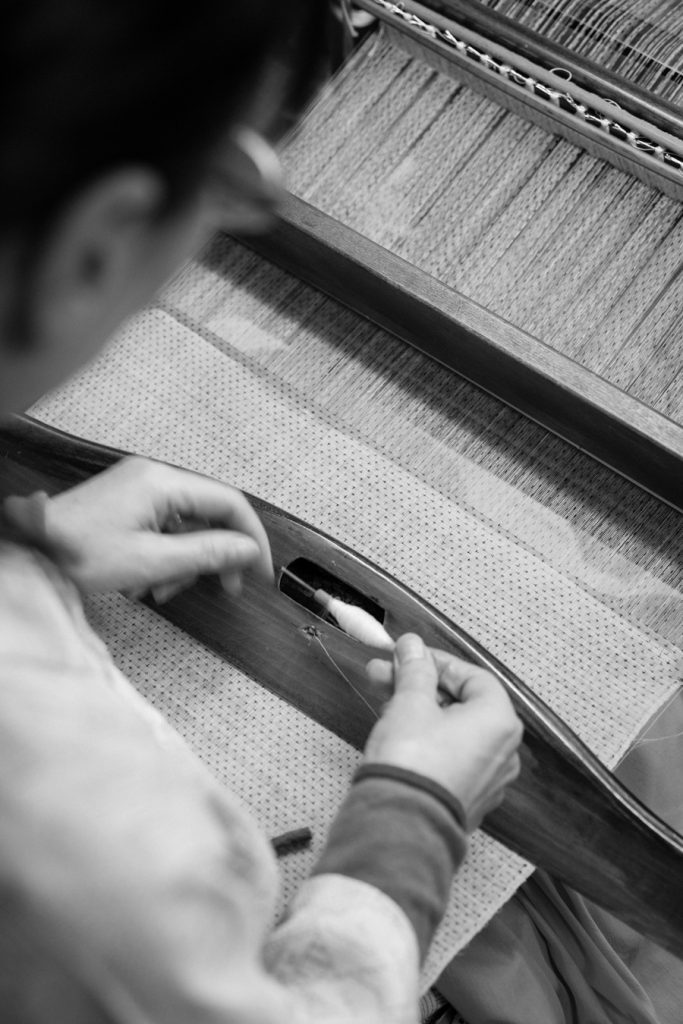In YUKIGUNI (snow country), the weaving industry has always been a popular winter job. The exquisite handwork of the weavers has been highly valued.
Echigo Jofu
Echigo Jofu has a long history and is preserved in the Shosoin Repository, built in 756 AD. This suggests that it has been produced in the Shiozawa region for over 1,200 years. In the book “Hokuetsu Seppu” written by Bokushi Suzuki in the Edo period (1603-1868), there is a detailed description of life in YUKIGUNI and the making of Echigo Jofu. Today, due to the low production of the raw material, Ramie, and the ageing of the artisans, it may become a ‘mirage cloth’ in the near future.

“Echigo-jofu is entirely handmade. In order to produce a tenth of one hectare of fabric, it takes two years.” Ms Takanami is also engaged in raising the next generation of weavers. “If we neglect the tradition of Echigo-jofu, it will definitely die out…”, she says with an expression which conveys her strong determination not to let this tradition die.
Relation Between Kimono Fabrics And Snow
The weaving of Echigo Jofu requires an uncanny degree of patience. There are 50 stages in its production. The raw material is refined hemp fibre, which is split into thin strands with nails and twisted together to make yarn. The number and length of the threads are then decided according to the design, and the threads are patterned to create the “Kasuri pattern”, which is then woven.
It takes two to three months to weave one piece of cloth (about 12 metres). The cloth is then washed in water and exposed to the snow before being made into a finished product. This process, called “Yuki-sarashi“, is unique to Echigo Jofu, which uses plant fibre yarns. This process has a natural bleaching effect and is a special feature that heralds spring in YUKIGUNI.
In 2009, Echigo Jofu was registered as an Intangible Cultural Heritage by UNESCO. It is regarded as one of the best summer kimonos because of its exceptional crispness and texture.
“Shiozawa Tsumugi”, “Hon Shiozawa” and “Natsu Shiozawa” are silk fabrics made using the techniques of Echigo Jofu.
Shiozawa Tsumugi (Pongee)
Shiozawa Tsumugi (Pongee) is a silk weaving technique based on the linen weaving technique of Echigo Jofu, which dates back to around 1,770. It is characterized by the use of silk yarns for the warp and cotton yarns for the weft. The weaving is done by carefully matching the coloured individual threads. The result is a calm and elegant pattern. Shiozawa Tsumugi is designated as a traditional Japanese craft.
Hon Shiozawa
Hon Shiozawa is woven using silk yarns with a strong twist in the weft. After weaving, the strong twist of the yarn is restored by rubbing it in hot water, which produces a fine texture called “shibo”. The result is a fabric that feels soft against the skin and has a delicate, elegant pattern. Hon shiozawa is designated as a traditional Japanese craft.
“Hon-Shiozawa” and “Shiozawa Tsumugi” (two other types of fabric) have been designated by Japan as traditional crafts. However, while there were as many as 45 textile workshops in Shiozawa during the golden age of the region’s local textiles, now only 9 remain.
Let’s Go To YUKIGUNI
Natsu Shiozawa
Natsu-Shiozawa was created as a summer silk fabric using the techniques of hemp weaving. The weft is made of strongly twisted yarns, and the density of the weave is deliberately coarse to create a transparent effect. It is a summer textile that gives a cool feeling.
Things to do
Discovering YUKIGUNI Tour
A special 4-day itinerary to discover the culture of the snow country, including weaving.


-1024x626-2.jpg)
